Denon Tunpu Ancient Village is located in Anshun Pingba District ,72 kilometers away from Guiyang. The voice, costumes, residential architecture and entertainment of the Tunpu people are very different from the surrounding villages. This unique Han culture phenomenon is called “Tunpu Culture”, and one of the most representative is in Denon Tunpu Ancient Village. Denon Tunpu was an important station on the ancient Shunyuan Road in the Yuan Dynasty. At the beginning of the Ming Dynasty, Zhu Yuanzhang (the emperor of the Ming Dynasty) recruited a large number of soldiers here. The local Confucian scholar was renamed "Denon Tunpu" this century.
The Tunpu people still retain the tradition of six hundred years ago in terms of language, costumes, architecture, religious beliefs, life customs, food culture and so on. There are more than 1,000 households in Denon Tunpu Ancient Village, they inherited the Han culture of Jiangnan in the Ming Dynasty. On festivals, people always were specific costumes to perform Di Drama or sing their folk songs.
Architecture
Walking into this ancient village is just like walking into a stone world. You can see the stone, the hand touches the stone, and the foot is on the stone.
The stone house of Denon Tunpu reflects the perfect combination of residence and military. When there is no war, it is a residential building, and when it is a war, it is a defense facility. The stone wall is tall , thick and firm. And a number of watchtowers are setted up in Tunpu. These watchtowers have a stone window on one side of the street, which is mainly used for observation and contact during wartime. The Tunpu residential buildings are not only independent, but also integrated that can be connected through the back door.
The stone alleys in Denon Tunpu Ancient village are criss-crossed, connecting the entire village as a whole.
In addition to, these stone buildings also contain Jianghuai civilization and exquisite architectural skills. The wood carving and stone carving art from Jiangnan can be seen everywhere. The small courtyard is full of carved patterns, and the carved wooden door is engraved with various patterns.
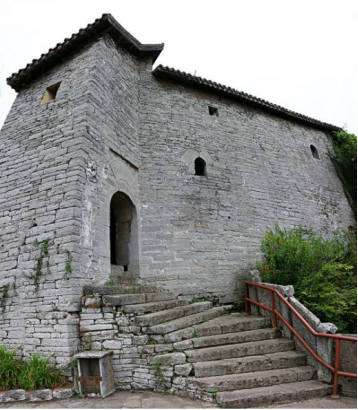
Stone House, Denon Tunpu Ancient Village
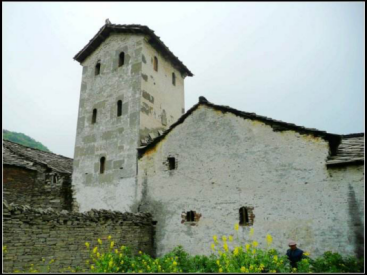
Watchtower, Denon Tunpu Ancient Village
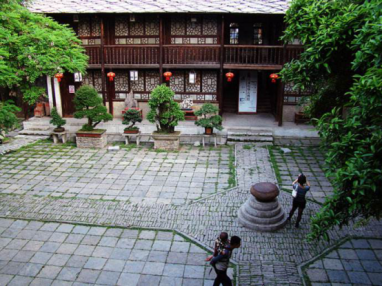
Courtyard, Denon Tunpu Ancient Village
Costumes
Tunpu women always wear robes which reach the calves. The color of robes is generally cyan. The hair style of the Tunpu women is like a phoenix head. The hair on the left and the right is pulled up in front of the ear, the center hair is rounded in the back of the head. A jade hairpin is covered with a round net of ponytail textile, and then wrapped in the top of the forehead to the back of the head.
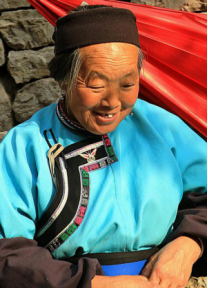
Women Robes, Denon Tunpu Ancient Village

Women Hair Style, Denon Tunpu Ancient Village
Di Drama
Di drama originated from Junnuo in the Ming Dynasty. Junnuo is a kind of ceremony used by the ancient army to invigorate the military and intimidate the enemy before wars. The Di drama is an inheritance and development of the Nuo culture and it occupies a very important weight in the Tunpu culture. It is a spiritual sustenance and symbol of the Tunpu people. This form of folk drama has the effect of acting and exorcism. The costumes of the local opera are generally blue or white gowns and trousers,with a battle flags which are behind the actors. The props are 18 weapons such as wooden knives, swords, and axes. In addition to , the actor needs to wear a mask. The accompaniment of Di Drama is commonly percussion instruments such as bronze gongs and leather drums.
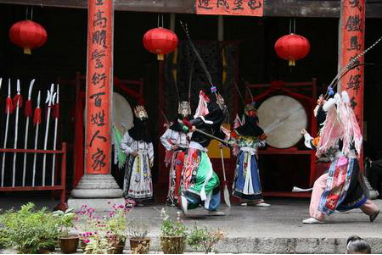
Di Drama, Denon Tunpu Ancient Village
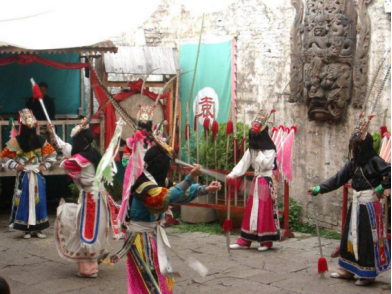
Di Drama, Denon Tunpu Ancient Village

